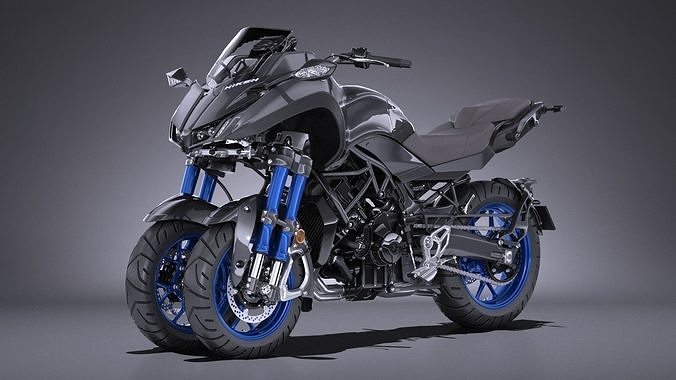Yamaha Niken Features, Design & Ride Experience Uncovered
The Yamaha Niken has redefined what it means to ride a motorcycle. With its revolutionary three-wheel design and cutting-edge technology, it challenges everything we thought we knew about performance, stability, and control. In this article, we delve deep into the Yamaha Niken’s features, design elements, and what it’s really like to ride this futuristic machine.
The Concept Behind the Yamaha Niken
A New Category in Motorcycling
The Yamaha Niken isn’t just a modified bike — it’s a category-defining machine. Blending the agility of a sportbike with the stability of a three-wheeler, Yamaha calls it an “LMW” (Leaning Multi-Wheeler). This concept allows the front wheels to tilt in unison with the chassis during turns, delivering an experience closer to a motorcycle than a trike.
Why Three Wheels?
The addition of a second front wheel increases contact with the road surface, significantly improving grip, especially in wet or unstable conditions. This results in better braking performance, greater cornering confidence, and overall improved safety without sacrificing the thrill of riding.
Features of the Yamaha Niken
Engine and Performance
At its heart, the Yamaha Niken is powered by an 847cc inline 3-cylinder engine, the same powerhouse used in the MT-09. It produces around 115 horsepower and 87.5 Nm of torque. The engine delivers strong mid-range performance with a satisfying growl, thanks to Yamaha’s Crossplane Concept that enhances linear torque delivery.
Advanced Suspension and Steering
The Niken’s standout feature is its unique dual front fork suspension system. Each front wheel is supported by its own set of upside-down forks, offering incredible cornering stability. This setup allows for aggressive lean angles (up to 45 degrees), something rarely possible on other three-wheeled designs.
High-Tech Rider Aids
Yamaha has equipped the Niken with a suite of modern rider aids, including:
Traction Control System (TCS)
Quick Shifter (upshift)
Cruise Control
Multiple Ride Modes
ABS (Anti-lock Braking System)
All of these systems are designed to enhance safety and customization for different riding styles or road conditions.
Ergonomics and Comfort
Long rides are not just possible — they’re encouraged. The riding position is upright and relaxed, providing excellent comfort. The seat is spacious, and the fairing offers decent wind protection, making the Yamaha Niken suitable for sport-touring enthusiasts.
Design Elements That Turn Heads
Bold and Aggressive Styling
There’s no denying it: the Yamaha Niken looks like it’s straight out of a sci-fi movie. The front end is muscular and wide due to the dual wheels, while the rest of the bike maintains a sleek, aggressive stance. The LED headlamps are sharply styled, and the exposed mechanical components give it a rugged, industrial aesthetic.
Functional Aerodynamics
Yamaha didn’t just focus on looks. The bodywork is shaped to improve airflow, reduce drag, and protect the rider from wind fatigue. Integrated winglets and fairing vents contribute to high-speed stability and a premium feel.
LED Lighting and Digital Display
The full LED lighting setup not only enhances visibility but also adds to the bike’s modern character. A full-color TFT screen provides easy access to all ride data, including speed, gear position, fuel range, ride modes, and more.
Yamaha Niken Ride Experience
Unmatched Cornering Confidence
Riding the Yamaha Niken for the first time can be disorienting — in a good way. The dual-front-wheel setup grips the road like no traditional motorcycle can. On twisty roads, it feels planted and confident, allowing riders to push harder into corners with less risk.
Even in poor weather or on slippery roads, the added front-end grip makes the ride surprisingly worry-free. Riders report a sense of invincibility while navigating tricky terrain that would unsettle most bikes.
Stability at Speed
Thanks to its unique chassis and suspension geometry, the Yamaha Niken remains incredibly stable at highway speeds. Whether you’re on a weekend tour or tackling mountain roads, the Niken provides a secure and engaging ride.
Learning Curve and Adaptation
While the Niken handles like a traditional motorcycle, it does have a learning curve. The added front-end weight and steering feel are different from a two-wheeler. However, most riders adapt within a few hours and come to appreciate the added confidence and control.
Comfort on Long Journeys
Designed with touring in mind, the Yamaha Niken excels on long rides. The seat is comfortable, vibrations are well-damped, and the ergonomics reduce rider fatigue. Yamaha also offers accessories like side cases and heated grips for those looking to go the distance.
Pros and Cons of the Yamaha Niken
Pros
Unparalleled front-end grip and stability
Excellent engine performance and sound
Loaded with rider aids and tech
Unique design draws attention
Surprisingly agile for a three-wheeler
Cons
Heavier than a traditional sport-touring bike
Expensive compared to similar two-wheeled models
Limited storage unless accessories are added
May not appeal to traditional motorcycle purists
Who Should Ride the Yamaha Niken?
The Yamaha Niken is ideal for riders who want something out of the ordinary. It’s perfect for sport-touring fans, tech enthusiasts, and those who often ride in unpredictable weather conditions. It also appeals to older riders or those returning to motorcycling who want added stability without giving up the thrill of leaning into corners.
Conclusion
The Yamaha Niken is not just a motorcycle — it’s a bold statement in engineering and design. With its leaning multi-wheel system, advanced tech features, and exceptional ride experience, it opens a new frontier in motorcycling. While it may not be for everyone, those who give it a chance often find themselves converted by its unique blend of thrill and security.
Whether you’re looking for a cutting-edge machine or simply want to experience motorcycling from a new perspective, the Yamaha Niken delivers in ways few bikes can. It stands as a symbol of innovation and the future of two — or rather, three — wheeled transport.
